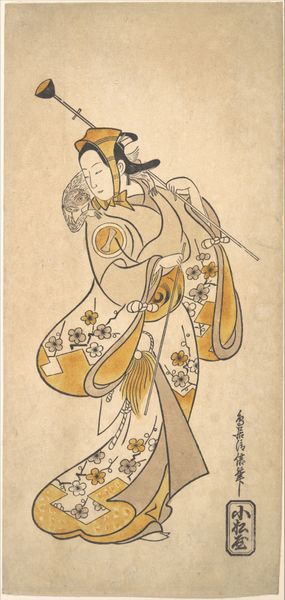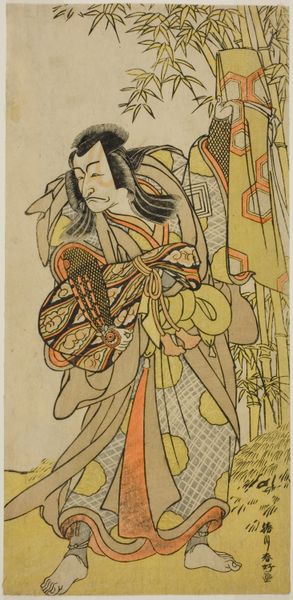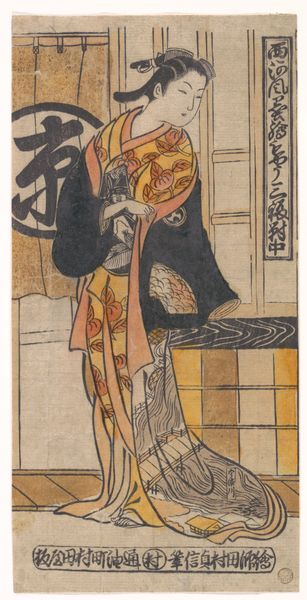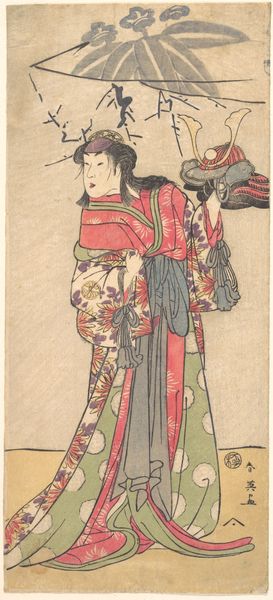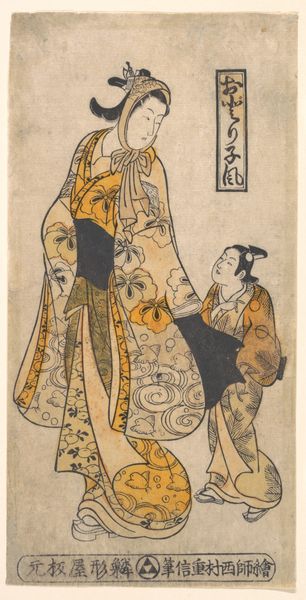
Courtesan and her Attendant under Cherry Tree c. 1780 - 1800
0:00
0:00
drawing, print, ink, woodblock-print
#
portrait
#
drawing
#
ink painting
# print
#
asian-art
#
ukiyo-e
#
figuration
#
ink
#
woodblock-print
#
genre-painting
Dimensions: 63 × 12 cm (38 7/8 × 13 7/8 in.)
Copyright: Public Domain
Curator: This ink and woodblock print from around 1780-1800, currently residing at The Art Institute of Chicago, is titled "Courtesan and her Attendant under Cherry Tree", brought to us by Chōkōsai Eishō. What are your initial impressions? Editor: There's an undeniable serenity about this scene. The figures, especially the courtesan, seem to carry a quiet dignity, and the falling blossoms soften the composition with their ethereal quality. Curator: It's a beautiful example of ukiyo-e, literally translated as "pictures of the floating world." These images gained immense popularity depicting the pleasures and fashions of Edo-period Japan's urban culture. What symbols resonate with you? Editor: Cherry blossoms themselves carry layers of meaning – the beauty, fleeting nature of life. There’s also an implicit social stratification displayed here. The intricate hairstyle and robes of the courtesan certainly speak to her status within society. She presents as an aspirational figure. Curator: Indeed. The courtesan's elaborate dress and hairstyle were fashion statements in Yoshiwara, the pleasure districts. The attendant reinforces this display of opulence but also speaks to the social structures that governed even the most glamorous settings. Editor: The gaze is also potent. She looks down as though she does not recognize the viewer. She is also uninterested in her assistant as though preoccupied and above even those immediately around her. Curator: These woodblock prints, or ukiyo-e, allowed these glimpses into the world of pleasure and performance to be shared much more broadly in society, contributing to celebrity culture and ideas about social mobility. The representation, of course, was carefully controlled, both commercially and politically. Editor: The fact that these woodblock prints were created for mass production and the accessibility they represent, juxtapose strangely to their subjects: women elevated high in culture due to their occupation and the culture around that occupation that was inherently restrictive. Curator: A sharp observation. The consumption of ukiyo-e became a way to participate, visually at least, in a lifestyle many could only dream of. It’s an interesting point of reflection. Editor: Agreed. Understanding this artwork allows us to engage with historical aesthetics while considering the complex socio-political backdrop of its creation.
Comments
No comments
Be the first to comment and join the conversation on the ultimate creative platform.


